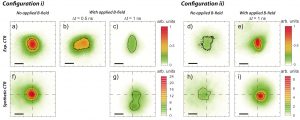Detail Page
2018.1.9
Our research result has been published in Nat. Comm..
The first demonstration of guiding of relativistic electron beam by the externally applied magnetic field has been published in Nature Communications.
Efficient energy transport in dense matter by laser-driven relativistic electron beams is crucial in many applications including the study of warm dense matter, inertial confinement fusion, and proton and ion acceleration by laser. However, the laser-matter energy coupling is in general impaired by the large divergence of relativistic electron beams, intrinsic to laser-plasma interactions.
A recent paper demonstrates the relativistic electron beam transporting efficiently its energy in dense plasma with an externally imposed strong magnetic field. The paper, entitled “Guiding of relativistic electron beams in dense matter by laser-driven magnetostatic fields” and published in Nature Communications on 9th January 2018 (DOI: 10.1038/s41467-017-02641-7), is the result of an international collaboration involving researchers from CELIA – University of Bordeaux-CNRS-CEA, ILE – University of Osaka, Polytechnic University of Madrid, LULI – Ecole Polytechnique-CNRS-CEA-University Paris-Saclay-UPMC: Sorbonne Universities, University of Oxford, University of York and Technical University of Darmstadt.
The experiment uses a novel technique entirely based on the laser-plasma interactions to deliver extremely strong magnetic pulses (above 500 T) developed recently within the same research consortium. It is successfully applied to confine radially the propagation of laser-driven relativistic electron beams and to achieve a five-fold improvement on their energy-density flux, transmitted into depths of solid matter. The efficiency of energy transport is a challenge for the front-end research on matter at extreme conditions similar to those found in the stars or in the planets’ interiors, controlling thermonuclear fusion reactions on a laboratory scale or improving the sources of high energy particles and radiation for applications in fundamental science, industry and medicine. That experiment is the first to show that it is possible within a time as short as a few nanoseconds to produce a strong magnetic field, have it to soak into the target, and then to guide the propagation of an intense and relativistic electron beam through the magnetized material. The success of that experiment was a necessary condition for many prospective studies of magnetized high energy-density matter.






